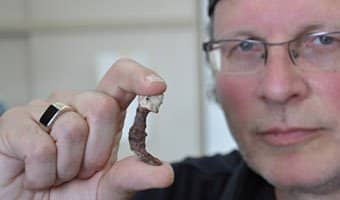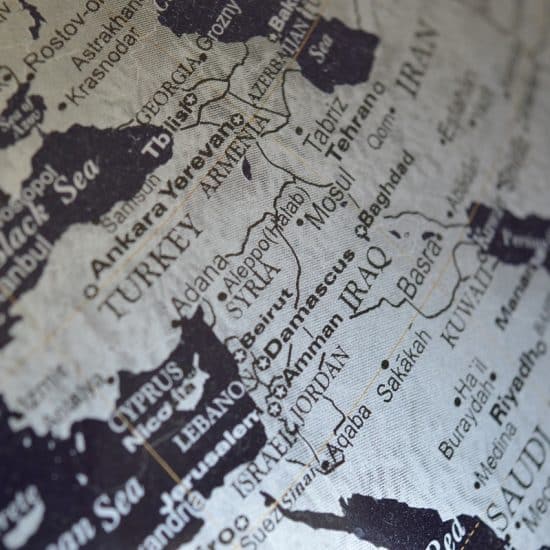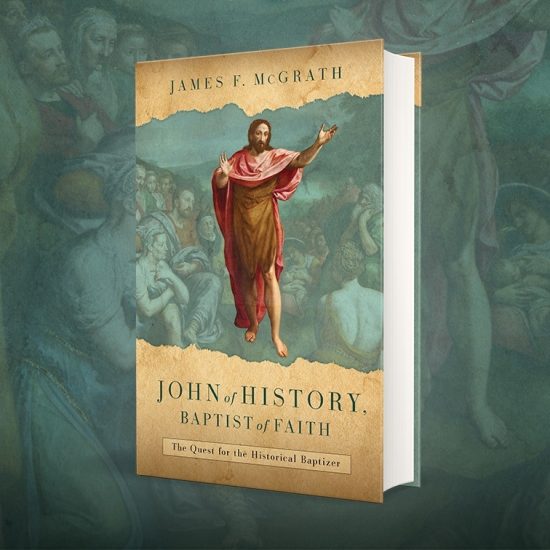JERUSALEM (RNS)—An Israeli-Canadian journalist believes he may have tracked down two of the iron nails used to crucify Jesus to the cross — or at least objects that could be the long-lost relics.
While researching a segment for the History Channel series Secrets of Christianity, host and producer Simcha Jacobovici learned something that startled him: In 1990, Israeli archeologists excavating a 2,000-year-old burial cave discovered two nails crafted by the Romans, but they kept the discovery quiet.

Journalist Simcha Jacobovici holds one of the nails that he believes may have been used in the crucifixion of Jesus. The nails reportedly were found in a tomb believed to be the burial site of Caiaphas, the Jewish high priest who handed Jesus over to the Romans for crucifixion. (RNS PHOTO/Courtesy Associated Producers Ltd.)
|
They did, however, publicize the discovery of two ossuaries — stone burial boxes filled with human bones — with the inscriptions “Caiaphas” and “Joseph son of Caiaphas.” The latter intricately carved ossuary toured the world and now is prominently displayed in the Israel Museum in Jerusalem. According to the Gospels, Caiaphas was the Jewish high priest who handed Jesus over to the Romans for crucifixion.
“There’s a general scholarly consensus that the tomb where the nails were found likely belonged to Caiaphas. Nails at that time were a dime a dozen, but finding one in a tomb is exceedingly rare,” Jacobovici said outside the high stone walls of the Old City, where Jesus spent his final days.
When Jacobovici found a brief reference to the nails in the official archeologists’ report, “my jaw dropped,” he said. “It would be as if, 2,000 years from now, archaeologists uncovered the cave of Muhammad Ali but neglected to mention the pair of boxing gloves found there. Sure, boxing gloves are common, but perhaps those particular gloves had special significance to the boxer?”
Jacobovici also hosts the Naked Archaeologist series on History International and collaborated with filmmaker James Cameron on the controversial 2007 documentary, The Lost Tomb of Jesus.
In the segment “Nails of the Cross,” which airs on the History Channel, Jacobovici attempts to discover why the researchers felt the nails were unimportant.
“Everything else is so meticulous, yet there are no photos or drawings or measurements of the nails. When I inquired at the Israel Antiquities Authority, I was told they had gone missing.”
“Caiaphas is known for one thing only — the trial and Crucifixion of Jesus,” Jacobovici said. “He may have felt compelled to take these nails with him to his grave.”
There also was the belief among some ancient Jews that nails had healing powers “and were a ticket to the afterlife. Other items found in the tomb show that this was a superstitious guy,” he added.
The history detective searched the IAA’s vast warehouses and then tried to find the location of the long-sealed tomb, which now lies beneath a public park. Finally, on a hunch, Jacobovici approached Israel Hershkovitz, a forensic anthropologist at Tel Aviv University, who also is expert on crucifixions.
“When I asked Hershkovitz if he’d received two nails about 20 years ago, he knew exactly what I was talking about and located them within minutes,” Jacobovici recalled.
Hershkovitz could not say where the nails had been found because the original packaging lacked the information. He could not be reached for comment.
While Hershkovitz knows for certain the nails came from the IAA, there’s no conclusive link that they came from the Caiaphas tomb. And Israeli archaeologists seem as reluctant to comment this time around as they were back in 1990.
When the anthropologist showed Jacobovici an ancient heel bone impaled with a nail—the only such crucifixion specimen ever unearthed—“I realized that the Caiaphas nails were similar, though shorter. The tips appeared purposely bent to keep them from falling off the wood.”
Jacobovici asked Hershkovitz whether the nails could have been used to crucify a person’s hands to a cross. Hershkovitz said “yes.”
The limestone residue on one of the nails clinched it for Jacobovici, “because one of the nails was found in the ossuary, the other on the ground” of the burial cave, where it would be exposed to limestone.
Gabriel Barkay, a professor of archaeology at Bar-Ilan University, called Jacobovici’s investigation “very challenging, very interesting, very intriguing, but it’s a TV show and not a scholarly study. There’s no proof whatsoever that they originate in the tomb of Caiaphas. It’s all conjecture.”
Nails were used for “many purposes,” Barkay noted, “from fixing iron gates to wooden doors and coffins.”
Ronny Reich, a Haifa University archeologist who deciphered the writing in the Caiaphas cave, believes the cave “belongs to a member of the Caiaphas family, but we have no evidence it belongs to the high priest.”
Jacobovici, however, is certain his research will withstand scrutiny, even if it seems largely circumstantial at first glance.
“Skepticism is good. As with the Shroud of Turin, you can’t be 100 percent certain, but believers don’t need 100 percent certainty. They need a solid ‘could be,’ and that’s what we’re offering.”






